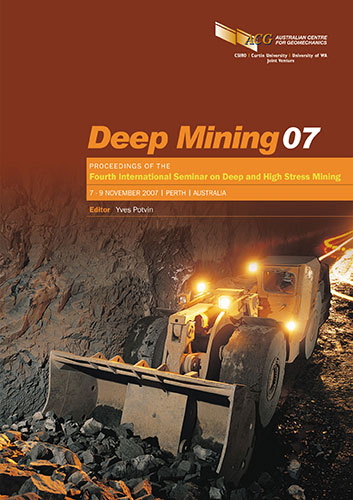Destressing the ROB5 Remnant Using Tight Slot Blasting at Mt Charlotte Mine

|
Authors: Kempin, M; Sprague, A; Narendranathan, S; Mikula, PA; Lee, MF |
DOI https://doi.org/10.36487/ACG_repo/711_7
Cite As:
Kempin, M, Sprague, A, Narendranathan, S, Mikula, PA & Lee, MF 2007, 'Destressing the ROB5 Remnant Using Tight Slot Blasting at Mt Charlotte Mine', in Y Potvin (ed.), Deep Mining 2007: Proceedings of the Fourth International Seminar on Deep and High Stress Mining, Australian Centre for Geomechanics, Perth, pp. 97-110, https://doi.org/10.36487/ACG_repo/711_7
Abstract:
The Mt Charlotte ROB5 orebody remnant had defeated two earlier attempts at stoping, with Richter magnitude (MR) 2.2 to 2.9 seismic events in 1995 and 1997 causing a halt to production. A destressing strategy, known as Tight Slot Blasting (TSB), was subsequently developed for this orebody. It was designed to manage fault-slip seismicity on several major structures intersecting the ROB5 area. The objective was to destress by creating a slot 150 m long and up to 40 m high along the entire western edge of the orebody. The concept was validated using a calibrated numerical modelling study, and the key elements involved tight firing (low blast expansion void) and rapid firing (electronic detonation). Mining commenced in August 2006. At that time, four particular R-shears (sub-vertical and striking NE-SW) were identified as requiring specific seismic management. A blasting schedule was defined using four TSB segments to advance the slot across these structures. To date, two TSBs have been conducted and 80% of the orebody has been destressed, but practical blasting issues have affected the project, and fault-slip seismicity has also been experienced. Bridging of intact rock across the slot has been a major problem, and methods of dealing with this have been developed. The main issue was long up-holes that toed into highly stressed, fractured and open ground below the previous ROB5 undercut. The largest fault-slip event, MR +2.2, was the same as the project maximum that was estimated in 2004. Ground support has generally performed well. The TSB strategy has provided the required control of event magnitude, but not event timing. This is a significant project. It has added 18 months to the life of the mine, and represents a rare attempt to achieve stope-scale destressing in the face of fault-slip seismicity.
References:
Lee, M. and Fotakis, D. (1992) Charlotte Deeps: 29 Level Virgin Stress Measurement. James Askew and Associates,
JAA 1724.
Mikula, P.A. (2001) Seismicity CS3 - 1380 area (Event No. 111729) on 18th November 2001. Internal Memo, KCGM
Mt Charlotte, November.
Mikula, P.A. and Lee, M.F. (2002) Forecasting and controlling pillar instability at Mt Charlotte Mine. 1st International
Seminar on Deep and High Stress Mining. Australian Centre for Geomechanics, November.
Mikula, P.A. and Lee, M.F. (2007) Empirical performance chart for ground support in seismic conditions at Mt
Charlotte. 4th International Seminar on Deep and High Stress Mining, Australian Centre for Geomechanics,
Perth, November.
Mikula, P.A, Lee, M.F. and Guilfoyle, K. (1995) Preconditioning a large pillar at Mt Charlotte Mine. Underground
Operators Conference, Kalgoorlie, pp. 265-272.
Mikula, P.A., Sharrock, G., Lee, M.F. and Kinnersly, E. (2005) Seismicity Management Using Tight Slot Blasting for
Stress Control at Mt Charlotte Mine. 6th International Symposium on Rockburst and Seismicity in Mines, Perth,
March.
Sharrock, G. (2004) Seismic Analysis of ROB5 Destressing. AMC Consultants Report No 204048 for KCGM Mt
Charlotte, June.
Destressing the ROB5 Remnant Using Tight Slot Blasting at Mt Charlotte Mine M. Kempin, et al.
110 Deep Mining 07, Perth, Australia
© Copyright 2025, Australian Centre for Geomechanics (ACG), The University of Western Australia. All rights reserved.
View copyright/legal information
Please direct any queries or error reports to repository-acg@uwa.edu.au
View copyright/legal information
Please direct any queries or error reports to repository-acg@uwa.edu.au